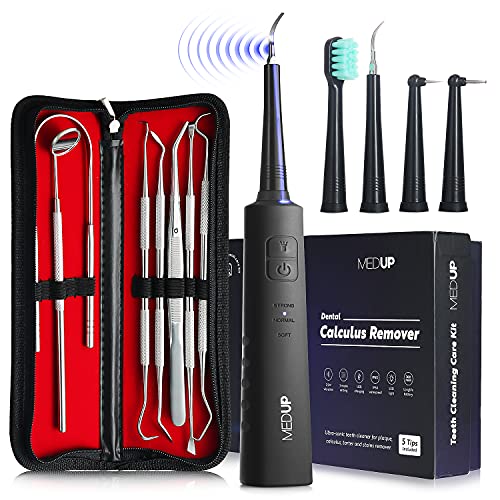Table of Contents
Dental calculus, commonly known as tartar, affects most adults and tends to worsen with age. When not properly removed, it can progress into a calculus bridge, which increases your risk of developing serious gum infections, disease or permanent bone loss around the teeth.
Roughly 70% of adults age 65 and older have periodontal disease—a condition that’s largely attributed to the presence of calculus, according to the Centers for Disease Control and Prevention (CDC)[1].
Fortunately, both calculus and calculus bridges are preventable. This article explains what exactly a calculus bridge is, including causes, side effects, treatment options and prevention methods.
What Is Calculus?
When dental plaque—a sticky film that develops on teeth due activities like eating and drinking—isn’t properly brushed and flossed away, it can combine with minerals in your saliva and eventually turn into calculus.
While plaque is easily removed with daily oral hygiene practices, calculus (or tartar, as it’s often called) is a hard substance that’s almost impossible to remove with brushing alone.
What Is a Calculus Bridge?
“A calculus bridge occurs when tartar or calculus builds up so much that it connects with the adjacent teeth and forms a solid ‘bridge’ of deposits,” explains Gary Schlotterer, D.D.S., founder of Digital Dentistry at Southpoint in Durham, North Carolina.
It often looks like “a border of brown or tan along the edge of your teeth by your gum line,” notes Gary Silverstrom, D.D.S., dentistry practitioner of the Silverstrom Group in Livingston, New Jersey. In more severe cases, a calculus bridge may extend down into the gum line or further up along the surface of the teeth, he adds.
Causes of a Calculus Bridge
Several factors can increase your risk of developing a calculus bridge, including:
- Poor oral hygiene
- Crooked or crowded teeth
- Smoking
Additionally, individuals (especially those who are older) taking certain medications such as those for high blood pressure, depression and bladder-control issues may find themselves dealing with a specific side effect known as dry mouth. Because saliva is a key component to overall oral health, individuals living with dry mouth may be more at risk for issues like calculus build-up and tooth decay.
Because calculus cannot be removed by brushing alone, allowing too much time between dental visits can also increase the risk of a calculus bridge. The more opportunity your dentist has to clean your teeth, the less calculus you will have. The less calculus you have, the less possibility there is for a calculus bridge to form.
Side Effects of a Calculus Bridge
Some degree of calculus buildup is normal and common, notes David Chen, D.D.S., dentist at Jackson Ave Dental in Long Island City, New York. However, an untreated calculus bridge can lead to side effects and the development of more serious conditions. “The most concerning side effect of a calculus bridge is its ability to induce gum disease,” adds Dr. Chen.
According to Dr. Chen, other potential adverse effects of a calculus bridge include:
- Halitosis (bad breath)
- Bleeding gums that are red and swollen
- Staining on the tartar that can turn it black or brown
- Gingivitis, a mild gum disease that causes inflammation of the gums
- Periodontitis, also called periodontal disease, which is a serious gum infection that can result in permanent bone loss around the teeth
How Is a Calculus Bridge Treated?
Only a licensed dental hygienist or dentist can remove a calculus bridge once it has formed.
“The process for removing mild calculus buildup is called a teeth cleaning, but a calculus bridge requires more than that,” explains Dr. Chen. Due to the fact that calculus can grow below the gum line, removing it requires a deeper cleaning, he says.
You May Also Be Interested In Bestselling Dental Cleaning Kit Available On Amazon
| # | Preview | Product | Rating | Price | |
|---|---|---|---|---|---|
| 1 |
 |
Dental Tools, Plaque Remover for Teeth,… |
40,590 Reviews |
$8.47 | Buy on Amazon |
| 2 |
 |
Plaque Remover For Teeth Cleaning Kit – Gum… |
58 Reviews |
$28.98 | Buy on Amazon |
| 3 |
 |
Plaque Remover for Teeth – Ultrasonic Tooth… |
943 Reviews |
$42.98 | Buy on Amazon |
One (or both) of the following methods are often used to remove a calculus bridge:
- Hand instruments, such as scalers and curettes, which manually scrape and remove calculus buildup.
- Ultrasonic instruments, which vibrate at high speeds to break down calculus for removal.
Depending on the severity of the calculus bridge, more than one session with your dentist may be needed to remove it. However, it’s important to complete the removal process to prevent the calculus buildup from worsening.
How to Prevent a Calculus Bridge
A calculus bridge is preventable, but once it forms, it can be difficult to remove. Therefore, it’s crucial to follow proper oral hygiene practices to prevent a calculus bridge from forming in the first place.
“Dental hygiene is key when it comes to preventing the buildup of calculus and the formation of a calculus bridge,” says Dr. Silverstrom. “Since dental calculus can start building up within just a few days of the formation of plaque, you want to be vigilant about removing plaque before it gets to that point.”
According to the American Dental Association, there are steps you can take to reduce plaque and calculus buildup, including:
- Brushing your teeth twice daily
- Flossing daily
- Limit sugary drinks and snacks
- See a dentist regularly for cleanings and check-ups
When to See a Dentist
Regular visits to your dentist can help prevent the formation of calculus. When you maintain healthy oral hygiene habits and complete regular dental cleanings, tarter is less likely to form. However, if you start to notice calculus formation on your teeth, make an appointment with your dentist as soon as possible.
“You should see a dentist every six months to remove any calculus that may have formed. Despite how diligent you may be with your brushing and flossing, there will always be a nook or cranny that you may have missed,” advises Dr. Chen.
“With that being said, even if some calculus forms, as long as you keep up with your oral hygiene, you can significantly slow the bridge formation until you’re due to see your dentist,” he adds.
While a calculus bridge can lead to serious oral health problems, it’s preventable with proper oral hygiene. Brush and floss regularly, see your dentist for cleanings and check-ups, and limit sugary snacks and drinks when you can. If you do notice calculus forming on your teeth (and you might since it’s very common), consult your dental team about appropriate next steps.
Consult a Dentist
Use Zocdoc to find local dentists who take your insurance. It’s simple, secure and free.


